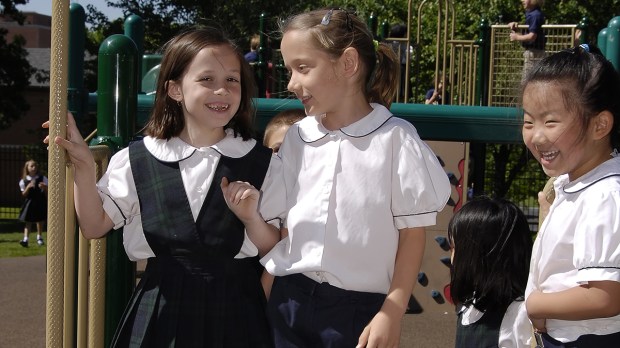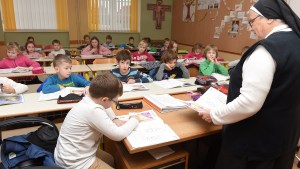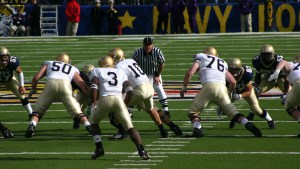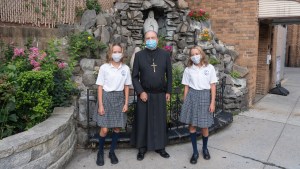While it is necessary to clearly affirm the Catholic identity of the 218,000 Catholic schools in the world, the Church “proposes” it but should not to impose it, emphasizes Archbishop Vincenzo Zani, secretary of the Congregation for Catholic Education, who explains to I.MEDIA the issues at stake in the new instruction of the dicastery published on this theme on March 29, 2022. The document calls for the resolution of internal conflicts related to this identity, but does not intend to establish “tribunals” in these schools, which must remain “open to all,” says the former teacher and vice-director at one of the world’s many Catholic schools, which in total serve 63 million students.
What prompted the Congregation to produce this document? Was it to respond to a particular problem in Catholic schools?
We publish a text of this kind every two or three years. In the last few decades we’ve already dealt with various topics such as the role of lay teachers, sex education, gender … This is our dicastery’s 12th document. It’s the fruit of a long period of work, based on the ad limina visits of the bishops of the world, who present us with the problems that arise in their particular Churches. The Instruction contains three fundamental guidelines: to emphasize more strongly the identity of Catholic schools in the face of a pluralistic market and a fragmentation of culture; to include Catholic schools in the Church which reaches out, which knows how to speak a new word today; and to encourage Catholic schools to participate in the Global Educational Pact.
What are the major novelties of this instruction?
In the second chapter in particular, we’ve emphasized a very important point: the special role of the diocesan bishop. According to the Code of Canon Law (can. 806), he is the one who has the duty to watch over Catholic institutions; he is a reference point. In the dicastery, when we receive letters of complaint describing this or that problem in a school, we direct them to the bishop. The bishop is the competent authority. For our part, we give the bishop guidelines so that he knows how to navigate while avoiding extremes, from excessive authoritarianism to total laissez-faire.
Another novelty: the third chapter deals with current challenges. We drew on all the surveys done at the time of the great world congress on education that we organized in 2015. It’s clear that we are living in a change of era, which also puts education in crisis. We’re laying down the foundations to immerse ourselves in this reality and face these questions as a Catholic school.
In many countries, the question of Catholic identity can sometimes be debated in certain institutions, and more widely in society. Some people denounce the risk of an exclusive identity-based approach. Moreover, the instruction warns against a “closed” approach to teaching. Do you reject every defensive posture that considers Catholic schools to be in danger today?
Identity is not a defensive notion; it’s a force of positive proposal. Every Catholic school must express its educational project clearly, but it proposes it, it does not impose it. And this identity, which is inspired by the Gospel, becomes an attractive factor. In many Middle Eastern countries, for example, 90% of our students are Muslim. We’re careful not to impose Christianity; they are the ones who insist on going to Catholic school. Some people would tend to demand that only Catholics have access … But Catholic schools are open to all! And if they’re open to all, they’re also open to the problems of today.
On the other hand, some media outlets have seen in your document a call to order allowing teachers to be dismissed if they question the Church’s positions, especially its sexual or social morality.
We ourselves are surprised to read this. It’s not enough to quote one little phrase, omitting the very complex contexts. We cannot bury our heads in the sand when faced with certain situations. One thing needs to be made clear here: in most cases, the reports come from families and parents of students who are asking for clarification and asking specific questions about the mission and identity of the school for which they have made this educational choice. If a teacher is causing a problem that puts an entire school in crisis, the administration must take responsibility.
For us, Catholic schools are not only a place of instruction where knowledge is piled up; they are a place of education of the whole person, of maturation, of growth. If a teacher isn’t able to do this, decisions must be made accordingly.
But this does not mean that the instruction is establishing tribunals in schools. We know of many very delicate situations, which we accompany with patience. In the Church, before making decisions, we reflect, we listen, we help, and we try to resolve the situation in proportion to its gravity.
The Instruction also stresses the importance of “protecting minors” in school settings, mentioning the need to put “all the necessary procedures” in place to defend the dignity of the students. What do you recommend in this regard?
We have brought up this situation because these are problems that we can encounter, and they must be faced seriously. The document does not give specific guidelines. Catholic schools must conform to the legislation of their country and of their dioceses, according to the norms that the bishops have received from the Holy See.
Finally, your instruction calls for “internal conflicts” of the Church not to be taken to other legal bodies. What kinds of conflicts are you referring to?
Today the world of Catholic education is faced with a series of problems caused by demographic changes, the decline in religious vocations, secularization, the social malaise of young people, the virtual bubbles of social networks, and the lack of teachers. The Church cannot face all these challenges alone; it needs to collaborate with society, with the laws of the State, but it must do so with prudence. This cooperation must respect the various jurisdictions and responsibilities, without interference. We must be attentive to the laws of the State, but also to our vision, which has a place in today’s culture.




